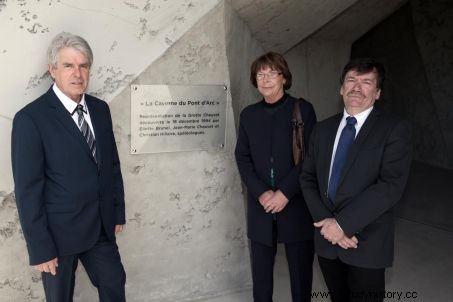After 24 years of litigation, a historic agreement has been signed between the discoverers of the Chauvet cave, the Ardèche department and the Auvergne-Rhône-Alpes region.

The large panel of Horses, in the Chauvet - Pont d'Arc cave (Ardèche) listed as a UNESCO World Heritage Site, in 2014.
The end of a psychodrama? 24 years after the discovery of the Chauvet cave (Ardèche) by three speleologists on December 18, 1994, a financial agreement has finally been reached between all the parties, as announced by the website of the daily Dauphiné Libéré , January 26, 2018. The discoverers indeed felt aggrieved since the discovery of the famous prehistoric decorated cave, one of the oldest in the world (37,000 years). An event actually considered one of the greatest archaeological discoveries of the XX th century, the site having been classified as a UNESCO World Heritage Site in June 2014. A conflict notably opposed them to the mixed syndicate of the Caverne du Pont-d'Arc – this replica of the original cave (closed to the public) which was opened in 2015– either the department of Ardèche and the Auvergne-Rhône-Alpes region, owner of the site. A procedure which also concerned the manager of the Cave, the Kleber-Rossillon company. A common ground therefore seems to have been found between these different parties and Jean-Marie Chauvet, Eliette Brunel and Pascal Hilaire, the "inventors" of the decorated cavity, according to the term in use.
 Jean-Marie Chauvet, Eliette Brunel and Christian Hilaire, the three inventors of the Chauvet Cave, during the inauguration of the replica of the Caverne du Pont d'Arc, in 2015.
Jean-Marie Chauvet, Eliette Brunel and Christian Hilaire, the three inventors of the Chauvet Cave, during the inauguration of the replica of the Caverne du Pont d'Arc, in 2015.
This two-part agreement was signed in the salons of the Hôtel du Département, in Privas (Ardèche), on January 26, 2018. Thus "the mixed syndicate of the Caverne du Pont-d'Arc, pledged to pay 50,000 euros to the three "inventors", in return for the intellectual property of the photos and videos taken at the time of discovery “, according to AFP, giving him the right “to freely use the name of Chauvet cave ". We remember that faced with the intransigence of the discoverers, who put forward their rights to the name, the official name chosen for the site was "Caverne du Pont-d'Arc". A second financial agreement concerns him, the collection by the 3 discoverers of 1.7% of the price of the entrance ticket (15 euros) of the replica.
So after so many years and dozens of legal proceedings, why is this deal happening now? Want to turn the page? This arrangement seems this time to be that of reason, in a human story which from the outset implicitly mixed a request for recognition, unfailing bonds of friendship and a feeling of spoliation linked to an original fault attributed to the Ministry of Culture of the time:he had indeed granted a press agency the right to use the photos of the cave taken by the speleologists themselves, during the discovery. A case with twists and turns, of which even the most fervent supporters no longer saw the end, thus finds its epilogue.
The Chauvet Cave
Revealed to the world in 1994 by speleologists Jean-Marie Chauvet, Christian Hilaire and Eliette Brunel, the spectacular decorated cavity of the Ardèche gorges discovered in the Cirque de l'Estre, near the Pont-d'Arc site, contains some of the oldest prehistoric parietal works known to date. Dated to 37,000 years ago, 425 figures left by early Aurignacian artists represent more than 14 animal species (horses, lions, woolly rhinos, bison, or deer), preserved for nearly three hundred centuries. To this abundant bestiary are added engravings, handprints and traces on the ground as well as quantities of bone remains, scratches and bear wallows, an animal very present in the imposing 800m long cave. Inaccessible to the public, the decorated cave has been replicated on the hills of Razal, seven kilometers from Vallon-pont-d'Arc (Ardèche). A restitution space whose success has not been denied since its opening in 2015. In February 2017, more than one million visitors had been welcomed there.
